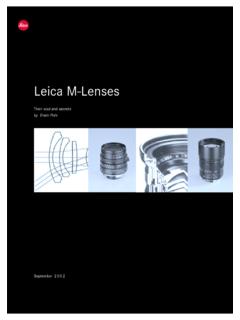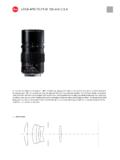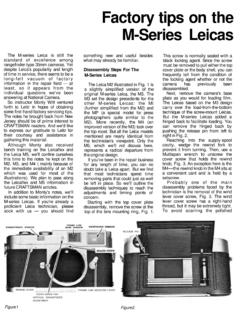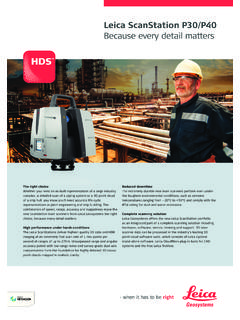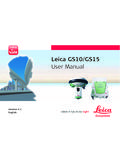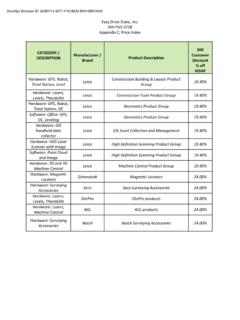Transcription of Kapitel 12 eng - Thorsten Overgaard
1 leica R-Lenses by Erwin Puts April 2005. Chapter 12: 35-70 mm lens _ leica VARIO-ELMAR-R 35-70 mm f/4. Chapter 12 leica R lenses 1. _ leica VARIO-ELMAR-R 35-70 mm f/4. Background The first zoomlens for 35mm cameras was introduced by The large size of the early zoomlenses may be explained by Voigtl nder around 1960 and named Zoomar with a focal this restriction. length range from 36 to 82mm. The Zoomar was an Early zoomlenses had commendable performance, but could American invention (USA Patent 2 454 686) and Voigtl nder not approach the level of quality, one could get with fixed was quick to see its potential. In Germany the system was focal lengths. designated as Gummilinse (rubber lens) to focus on its pri- The Zoom-Nikkor 1 mm initiated the breakth- mary characteristic as a lens with continuously variable focal rough of the zoomlens as a standard lens and quickly beca- length or variable magnification, which is the same idea.
2 The me the favourite of the fashion photographers of the sixties. design possibilities of a lens system with moveable elements This lens displayed two remarkable characteristics: it was a were already known in 1902, when the first American patent high contrast lens with limited resolution and it had a high was filed. The optical and mechanical complications are level of distortion. For optical designers it was a nightmare, quite complex and it took a full generation before the first but for the photographers it could unleash a new amount of workable systems were introduced. Siemens was one of the creative freedom. first in Germany to create a zoomlens for 16mm cine Leitz was quite reluctant to get involved in this area of zoom- cameras already before 1939, but the war made a large-scale lens design.
3 As an historical aside one may note that Leitz did commercialisation impossible. have a large department for zoomlens design, but the results The correction for optical aberrations has to very good over were limited to studies and prototypes. the whole range of focal lengths, but strictly speaking, this is The demand for zoomlenses was high and Leitz offered third- only possible for one specific focal length, most often the party products from Angenieux and Schneider as an alterna- middle position of the total range. All other positions will pre- tive. Later Leitz cooperated with Minolta and offered from sent some aberrations. It was necessary in the early period 1983 the leica VARIO-ELMAR-R 35-70 mm as a leica of zoomlens design to restrict oneself to the shorter focal branded lens.
4 In 1990 leica added the leica VARIO-ELMAR- lengths. The image quality will be negatively influenced when R 28-70 mm to it lens range. This Sigma design the focal lengths of the individual lens elements are short in displayed the same performance profile as the earlier Nikkor relation to the overall focal length. The individual lens ele- lens and as the Minolta design: medium to high contrast, ments will have longer focal lengths if you build the lens as limited definition of fine detail and fairly large distortion at long as possible. the extreme positions of the focal range. Chapter 12 leica R lenses 2. The leica design team had a higher level of ambition and wanted to create zoomlenses at least as good as the leica lenses with fixed focal lengths. To set such an ambitious goal is a formidable task, but in 1998 leica introduced the superb leica VARIO-ELMAR-R 35-70 mm ASPH.
5 (The first leica designed zoomlens was the leica VARIO-ELMAR-R. 70-180 mm from 1995). Lens shape 35 mm This lens demonstrated without any doubt that zoomlenses have the potential to provide image quality that is better than what can be accomplished with lenses with fixed focal lengths at comparable apertures. This is an important addi- tion and for very high-speed lens designs, a fixed focal length is still the best solution. At least in a practical sense: it might be theoretically possible to design a very high-speed zoom- lens with excellent quality, but the size and weight would be too large. The trend to digital cameras with smaller sensor Lens shape 50 mm sizes will present great opportunities for high-speed zoom- lenses with excellent image quality. The leica VARIO-ELMAR-R 35-70 mm ASPH.
6 Was the first lens that could substitute a range of lenses with focal lengths from wide angle lens and the standard lens to the moderate telelens without loss of performance. A very elabo- rate manufacturing and assembly process was required to Lens shape 70 mm ensure that the actual performance of the lens matched the design specifications. By now this lens has achieved a cult status within the leica community and with reason. The comparison of lens diagrams should not be taken too far. A lens diagram gives a family resemblance and might even be A year earlier, in 1997, leica had introduced a lens with a seen as a lens genealogy. The most important aspects of a maximum aperture of 1:4 and the same range (35-70 mm) lens design, like the choice of glass and the employment of that offered almost identical image quality in a more conve- aspherical surfaces and the true shape of the surfaces, can- nient package: the leica VARIO-ELMAR-R 35-70 mm f/4.
7 Not be derived from the diagram as such. For some reason leica omitted the designation 'ASPH' for In my report of the leica VARIO-ELMAR-R 21-35 mm this lens, although it has an aspherical surface. 4 ASPH. I have explained why current vario designs can deli- ver improved quality, compared to fixed focal length designs. Optical considerations To repeat the main points: better knowledge of the design problems, new glasses with special properties and/or with high refractive indices and the insight into the possibilities of The leica VARIO-ELMAR-R 35-70 mm f/4 has 8 elements, aspherical surfaces allow the designer to create zoomlenses arranged in seven groups. One lens element has an aspheri- with great performance. cally pressed surface. The lens diagram indicates the two main groups and one can see that the front group has a close The first impression when looking at the pictures taken with resemblance to the front group of the leica VARIO-ELMAR- the leica VARIO-ELMAR-R 35-70 mm f/4 with slide films or R 35-70 mm f/ ASPH.
8 And the second group is adapted the current crop of colour negative films, is one of image cla- from the previous leica VARIO-ELMAR-R 35-70 mm rity and pure colours. There is a hint of Matisse here with his Casual inspection shows that the leica TRI-ELMAR-M 28-50 use of clean shapes and refreshingly pure colours. The colour mm f/4 ASPH. is also closely related to the leica Vario- rendition of the leica Vario-Elmar is subtle and powerful at Elmar-R, with the big difference that the M version has two the same time, and offers a good balance of saturation and aspherical surfaces. finely shaded hues. Chapter 12 leica R lenses 3. MTF - 50 mm (Aperture Stop ). 100 [%] Aperture Stop The background blur at wider apertures is quite smooth and retains its main outlines and the gradient from sharp to uns- harp has a gentle curve and is not too steep.
9 80. Large scale enlargements are needed to inspect the rendi- tion of very fine detail and here the combination of really crisp outlines of main subject shapes and the clear reproduc- 60. tion of small changes in highlight detail and shadow detail supports the impression of a picture made with a larger for- 40. mat camera. 20. Ghost images and secondary reflections hardly occur and can only be seen in strong back light situations. Effective coating, good internal blackening of the mount and of cour- 0. se the smaller diameter of the lens elements contributes to 0 5 10 15 20. this excellent behaviour. Y'[mm]. The description above is based on a visual inspection of pic- tures made with this lens. These aspects cannot be inferred leica VARIO-ELMAR-R 35-70 mm f/4 (50 mm). from the analysis of MTF graphs, but these graphs are nee- ded to provide a backup for the more personal impressions.
10 MTF - 70 mm The difference in performance between the 35, 50 and 70 (Aperture Stop ). mm position at the wider apertures is quite small, as can be 100 [%] Aperture Stop seen from the diagrams. 80. MTF - 35 mm (Aperture Stop ) 60. 100 [%] Aperture Stop 40. 80 20. 60 0. 0 5 10 15 20. 40 Y'[mm]. leica VARIO-ELMAR-R 35-70 mm f/4 (70mm). 20. 0 A verbal description would run like this: at maximum apertu- 0 5 10 15 20 re the overall contrast is high with excellent definition of Y'[mm] very fine detail over a large part of the image frame. There is some softening of edge contrast of small detail due to some colour fringing at white-black gradients. At the edges and in the corners of the image there is a visible softening in the leica VARIO-ELMAR-R 35-70 mm f/4 (35 mm) reproduction of fine detail, which becomes blurred.


